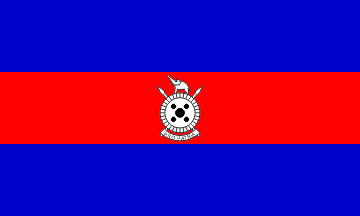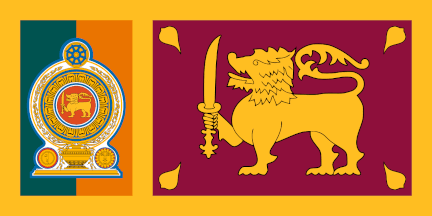

Last modified: 2024-11-09 by ian macdonald
Keywords: sri lanka | war flag | shield | elephant (white) |
Links: FOTW homepage |
search |
disclaimer and copyright |
write us |
mirrors
Smith (1982) describes this flag as blue
over red over blue triband with a black and white badge in the middle. The badge
consists of a circular shield in front of a two spears topped with an elephant
and with a ribbon below inscribed PRO PATRIA. This is presumably obsolete today.
Željko Heimer, 26 January 2003
Government vessels.
1870 - 1955. Blue Ensign, British canton, Ceylon badge.
1955 - ? Blue Ensign, Ceylon canton, crossed anchors.
Lighthouses and Tenders.
The Daily Mirror of 1 April 1976 reported that the Sri Lanka Navy Ensign had
replaced the White Ensign at Dondra Lighthouse. The details seem unlikely. The
replaced flag was probably the British Blue Ensign of the Board of Trade, which
at that time was operating the lights installed by the Ceylon and Minicoy
Imperial Lighthouse Service. I don't know when the Board of Trade took over the
Lighthouse Service in Ceylon (before 1916), nor whether there is a special flag
for Sri Lanka Ports Authority.
Ceylon Naval Volunteer Force.
1937- 1946. Blue Ensign, British canton, Ceylon badge.
Jack. Same, one size smaller.
Ceylon Royal Naval Volunteer Reserve.
1943 - 1946. British White Ensign.
Jack. Blue Ensign, British canton, Ceylon badge.
Royal Ceylon Navy.
1950 - 1953. British White Ensign.
Jack. Kandyan Lion (without green and saffron bands). 1953 - 1956. British White
Ensign.
Jack. National Flag with green and saffron bands. 1956 - 1972. Ceylon Naval
Ensign with St George's cross.
Jack. National Flag.
Sri Lanka Navy.
1972 - Sri Lanka Naval Ensign (without St George's cross).
Jack. National Flag.
David Prothero, 1 February 2003
 image by Zoltan Horvath, 12 October 2024
image by Zoltan Horvath, 12 October 2024
Looking at this
List of Sri Lankan flags, on the subtopic of
Military Flags, one can see that there's a flag called
President's
Colour in use since 1972, "A defaced national flag of Sri Lanka with Coat of
arms of Sri Lanka".
"When Sri Lanka declared itself a republic in 1972 the
units that had a Queen's Colour retired them. These were replaced by the new
President's Colour, which was first awarded in 1972. The following colours have
been awarded:
Army
Regiments
- Sri
Lanka Light Infantry in 1978
- Gemunu Watch in
1980
- Gajaba Regiment in
2007
Establishments
- Army Training Centre in 1972, laid up 20 August
1992
- Sri Lanka Military Academy in 1997
Air Force
-
Sri Lanka Air
Force in 1976
- SLAF Regiment in
2009
Squadrons
- No. 1 Flying Training Wing in 2001
- No. 2 Heavy
Transport Squadron in 2009
- No. 4 (VIP) Helicopter Squadron in 2009
- No.
9 Attack Helicopter Squadron in 2009
- No. 10 Fighter Squadron in 2009
Stations
- SLAF Katunayake in 2001
Navy
- Naval and Maritime
Academy in 2000
Source:
http://en.wikipedia.org/wiki/List_of_Sri_Lankan_flags#Military_Flags
Esteban Rivera, 12 July 2009
The significance of this Colour is very important as noticed here:
"The
colour is basically an emblazoned flag and its origin can be traced back to the
days when monarchies were the order of the day. The King in those ancient days,
would have his colour carried to battle. The colour served as the rallying point
around which the battle raged fiercest. It followed therefore that the colour
became a trophy for which men would gladly die, to defend. Consequently, the
colour aroused deep feelings of patriotism and pride and an almost religious
aura was built around it. As the range of modern weapons lengthened the Colour
no longer served as a useful rallying point and no longer was the carrying of
the Colour conducive to the modern concept of war. Consequently, Colours were
not taken to battle but were used only in ceremonies to lend greater dignity to
such occasions.
The Colour and the awarding of the Colour are ancient
customs that are etched firmly in our heritage; customs which were established
long before the advent of the foreign invaders from the West. The three lions on
the gateway of Sanchi (Circa 3rd Century B.C) have been identified as the Royal
Arms of Sri Lanka (seen here:
http://en.wikipedia.org/wiki/Coat_of_arms_of_Sri_Lanka). The peacock on it
signifies the banner of the Mayura. The arch contains representation of the
dispatch of the Bo-tree to Sri Lanka and the symbols on either side of the panel
depict the standard of Asoka and the Sinhalese monarch Devanampiya Tissa. This
is the first representation we have of the Sinhalese Royal Standard.
A
16th Century fresco at Dambulla depicting King Dutugamunu's victory over Elara
shows King Dutugamunu’s Colour being borne by his Colour bearer, during the
combat. The emblems on the flag are the sun and the moon, the stars and the lion
with a sword in its paw. In the book titled "Sinhalease banners and standards"
by Mr Edward W. Perera it is stated that the Royal flag flown in the
Kotte Palace in the 18th Century was flown on a
staff surmounted by the golden tassel wrought in a gold thread. At the four
corners of the banner four bo leaves were worked in gold thread while the centre
displayed a royal lion (Sinha Raja) holding a sword.
In Sri Lanka from
the earliest times flags were carried not only in religious processions but also
in war. Thus in these festival as well as in war there is little doubt,
according to the historian Mr. Perera, that the addition to the standards of the
kings, the banners of the princes, provinces and departments of the realm were
also carried. The armies or Parakramabahu the Great marched to the conquest of
South India and Pegu under the Lion Banner of Sri Lanka.
The Maha Dissawe of the four Korales of the Kandyan Kingdom who was
privileged to lead the way in war as well as in the Annual Dalada Perahara, had
borne before him five insignia as marks of special honour. One of the insignia
is the "Ira Handa Maha Kodiya" or translated the great sun and moon flag.
Elsewhere it is stated that the "Dissawas" also had the privilege of bearing the
‘Golden Tassel’ on the banner of the provinces. This is normally confined to the
Royal flag but was granted as a distinction by the king to be used by the
recipient.
In the Uggalboda Sannas, it is recorded that a royal grant in
the period of King Sri Parakramabahu the VIth invested a chief with the
privilege of bearing the king’s flag along with some other royal insignia. Thus,
the Sannas state, was conferred on chiefs whom the king specially delighted to
honour.
Thus, it is seen that the awarding of colours is indeed a very
old Sri Lankan tradition. In the chronicles it is stated that when the King’s
Colour was borne, it was borne by five people; one man carried the tall pole
fixed in the middle of his waist band for additional support and four other
people held the ends of the cords attached to the four corners of the standard
to keep it in position as it was borne along. In front of the flag, the
chronicle status, went a ‘Maha-Bamba’ (a tall man) mean to avert the evil eye
from the Colour to the tall fantastic figure that preceded it!"
Source:
http://www.airforce.lk/pages.php?pages=the_significance_of_the_colour
The President's Colour awarded to an Air Force Base/Unit is the Sri Lankan Air Force
flag, displaying the coat of arms of the Base/Unit on the lower right part of
the flag, and in the middle is some sort of a streamer in the middle of the
flag, with the current President's flag. An example is the SLAF Regiment which
was awarded the President's Colour in 2009, shown here in the Victory Parade in
April 2009:
http://www.airforce.lk/uploads/victory_parade_10.jpg.
The
President's Colour awarded to the SLAF Regiment is located here:
http://www.airforce.lk/uploads/SLAF_Regt_Colours_Flag.jpg (notice the
Sri
Lanka flag (
http://en.wikipedia.org/wiki/File:Ensign_of_the_Sri_Lanka_Air_Force.svg) as
background and the coat of arms (
http://www.airforce.lk/uploads/Regiment_Crests.jpg) is displayed in the
lower right part, and the current President's flag
is displayed in the middle.
The Air Force Units/Bases awarded the
President's Colours are:
- Sri Lanka Air Force
http://www.airforce.lk/uploads/the_significance_of_the_colour.jpg
- SLAF
Regiment
http://www.airforce.lk/uploads/SLAF_Regt_Colours_Flag.jpg
- No. 2 Heavy
Transport Squadron
http://www.airforce.lk/uploads/2_Sqn_Colour_Flag.jpg
- No. 4 (VIP)
Helicopter Squadron
http://www.airforce.lk/uploads/4_Sqn%20Colours_Flag.jpg
- No. 9 Attack
Helicopter Squadron
http://www.airforce.lk/uploads/9_Sqn%20Colour_Flag.jpg
- No. 10 Fighter
Squadron
http://www.airforce.lk/uploads/10_Sqn%20Colour_Flag.jpg
- SLAF
Katunayake
http://www.airforce.lk/uploads/award_of_colours_to_base_katunayake.jpg
-
SLAF Base Anuradhapura
Sources:
http://www.airforce.lk/pages.php?pages=award_of_colours_to_slaf_formations
http://www.scramble.nl/mil/3/sriaf/orbat.htm
Esteban Rivera,
22 March 2010
![[Chief of Defence Staff]](../images/l/lk^chos.gif) image by Zoltan Horvath, 12 October 2024
image by Zoltan Horvath, 12 October 2024
The flag of the Chief of Defence Staff consists of three horizontal stripes,
they are light blue, orange and dark blue. The emblem of Office of the Chief of
Defence Staff is placed in the middle of the flag.
Images of flag:
https://www.ocds.lk/
https://www.ocds.lk/content/director-general-department
Zoltan Horvath, 12 October 2024